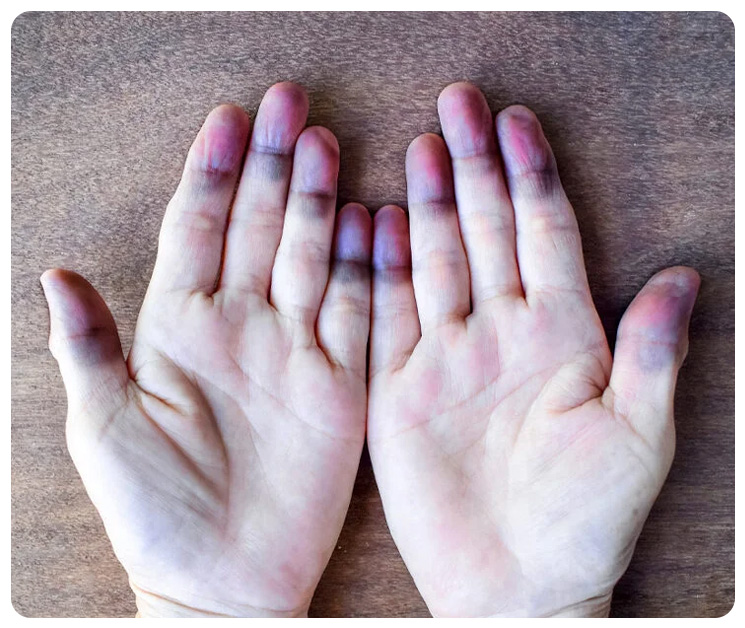

Cyanosis is a very common sign, which appears like bluish discolouration of the skin and mucous membrane. It has a significant impact on health and makes physician think of some critical disease.
DEFINITION OF CYANOSIS :
“Cyanosis” word came from Greek word “kyanos” which means “blue substance”. Cyanosis is defined as the bluish discolouration of the skin and mucous membrane, resulting from an increase in the reduced haemoglobin or of haemoglobin derivatives in the small vessels of those areas. Cyanosis occurs with more than 5gm reduced haemoglobin per 100ml of blood except in methamoglobianaemia and sulfhaemoglobinaemia.
The cyanosis depends on the 4 things-
Total amount of haemoglobin in blood.
Degree of unsaturation of the haemoglobin.
State of the blood vessels which must contain the reduced haemoglobin. because as if the vessels are constricted. the amount of blood is not sufficient to impart the cyanotic colour to the overlying skin.
Pigmentation and thickness of the skin occur.
CAUSES OF CYANOSIS :
PULMONARY:
CARDIOVASCULAR:
NON-CARDIOPULMONARY:
CLINICAL FEATURE:
TYPES OF CYANOSIS
“Acrocyanosis” refers to cyanosis found in the extremities, particularly the palms of the hands and the soles of the feet. It can also be seen on the skin around the lips. Acrocyanosis is often normal in babies, as long as no cyanosis is present in the central part of the body
“Central cyanosis” refers to cyanosis found on “central” parts of the body, including the mouth, head and torso. Central cyanosis is never normal in the newborn period and is almost always linked to a lower amount of oxygen in the blood
Clinical feature depends upon the etiology, intensity & duration of oxygen lack, plasma CO2 excess and subsequent acidosis.
HOMOEOPATHIC MANAGEMENT OF CYANOSIS
ARNICA MONTANA: Affects the venous system inducing stasis; deathly coldness of forearm; skin blue and black; hemorrhage from nose and mouth, with great strangling and suffocation.
ARSENICUM ALBUM: Icy coldness of body; blueness aggravated after every little motion; much emaciation; cold sweat; great debility.
BORAX : Cyanosis of infants from birth, circulation irregular; face bluish, especially around mouth, nose and eyes, with blueness of finger-tips and toes; during attack the child becomes prostrate and as if suffocating; the infant become pale nearly earthly colored.
CARBO VEG: Toes red, swollen; face cyanotic; pale, Hippocratic, cold with cold sweat; blue; mottled cheeks and red nose; veins stand out very full, remarkable blue.
CHINA OFFICINALIS: After hemorrhage collapse with waxy paleness and coldness; the veins of the face are distended.
DIGITALIS PURPURA: Child cannot be turned in bed or moved suddenly without nearly fainting and almost causing vomiting; eyelids, lips, tongue, nails become very blue; pulse unequal or very slow; coldness of peripheral parts; Cyanosis inequality of pulse, it varies; blue distended veins on lids, ears, lips and tongue.
LACHESIS: Suffocating spells and increased blueness, (<) sleeping, great tenderness of all the flesh; it is very difficult to handle the infant, the least touch seems to hurt it and to leave a deeper blueness, like a bruise; child faints from slightest motion; coldness of extremities.
LAUROCERASUS: A little exercise produces gasping for breath and increased blueness; ends of fingers and toes knobby and larger than any other part of the extremities; slow, feeble, almost imperceptible breathing with moaning; irregular beating of the heart, with slow pulse, soporous condition; (>) when lying still and in the open air, where oxygen can be inhaled.
PHOSPHORUS: Very tall and slender children, with much oppression of breathing and swelling of feet.
RHUS TOXICODENDRON: Face pale and bluish, especially lips; flabbiness of muscular tissue; great debility.
SECALE COR: Thin, scrawny babe with shriveled skin, especially when there are spasmodic twitching's, sudden cries, feverishness.
SULPHUR: To increase vitality and circulation, where other remedies failed.
PSORINUM: To increase vitality and circulation, where other remedies failed.